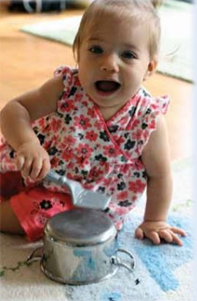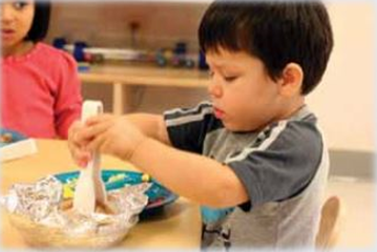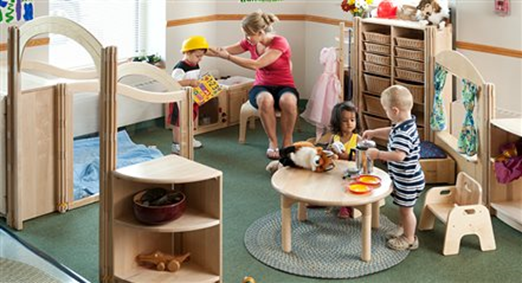15.7: Curriculum Planning
Infants and toddlers have an amazing capacity to engage in learning and rapidly organize vast amounts of new information. Clearly, an infant or toddler who is exploring how something works or interacting with an adult or other children reveals an active mind that is discovering and making sense of the surrounding world of people and things.
Infants and toddlers experience the world and build knowledge holistically during simple moments of play, exploration, and interaction with objects and with other people. They constantly gather new information and make sense of it. Their minds actively take in sounds, words, patterns of movement, and the actions and reactions of people, creatures, and objects. They integrate new information into an increasingly complex system of knowledge. As infants expand their encounters with objects and people, they try out emerging skills, discover new actions, and experience feelings in new ways. In moments of play, they experiment, investigate, and invent solutions, trying to figure out how things work.[1]

Contexts for Infant/Toddler Curriculum
In planning curriculum for the birth-to-age-three period, teachers must be aware of what infants and toddlers do in play, both when they act on objects and when they interact with adults and peers. In essence, play is the “work” of infants and toddlers. When teachers are mindful of the ways in which each infant experiences a moment of play, that child’s learning agenda reveals itself. In response, teachers are able to plan curriculum that aligns with the infant’s inborn learning agenda. In developing curriculum for infants and toddlers, teachers plan for three learning contexts:
- The play environment as curriculum. Curriculum plans include the selection of play materials that add interest and complexity to distinct areas where infants and toddlers freely play.
- Interactions and conversations as curriculum. Curriculum plans address ways of being with infants and toddlers during interaction, including nonverbal interaction, conversations, cooperation, conflicts, and times when infants express strong feelings such as delight, sadness, anger, or frustration.
- Caregiving routines as curriculum. Curriculum plans include care routines, particularly mealtimes, diaper changes, and naptimes. Intentional teaching invites infants and toddlers to participate in care routines that deepen their relationship experiences and open up possibilities for building emerging skills and concepts.[2]

Observation as the Basis for Planning the Infant/Toddler Curriculum
Planning infant/toddler curriculum begins with teachers discovering, through careful listening and observation, each child’s development. Observation is an essential teaching skill. When teachers mindfully observe, they find out how individual children make discoveries and make meaning within everyday moments of play and interactions.
Observing for the purpose of assessing individual children’s learning means carefully watching and listening with thought and reflection. In doing so, teachers find evidence of individual children’s meaning-making—how a child expresses or shows feelings, how a child responds to others’ feelings, and how a child responds to the impact of his actions on the objects he encounters or the people with whom he interacts.
When teachers observe infants’ play and interactions, they gather evidence that pertains to individual children’s social– emotional, language, cognitive, and perceptual and motor development. An observation can help teachers see, describe, and understand how an infant organizes feelings, ideas, skills, and concepts.
Sometimes, teachers may choose to write down what they observe in a note. They may also take a photo, or, with older toddlers, they may keep a sample of each child’s work. In doing so, teachers collect observational data that provide clear, vivid evidence of children’s development. Observing how children explore and play with newly introduced materials or ideas often makes it possible for teachers to track children’s developmental progress.
As teachers observe children’s play, exploration, and interactions, they discover ways to support children’s learning. Ideas for the next steps in curriculum planning emerge as teachers reflect on how they might extend or expand children’s exploration, problem solving, thinking, interactions, and language. Observation, reflection, and documentation in the moment simultaneously launch an ongoing assessment of each child’s progress in learning as well as the curriculum planning cycle.[3]
Observing While Participating

One of the key challenges for infant care teachers is to be able to observe and record their observations while providing early care and education. Learning how to address this challenge takes time and a good support system. Teachers can develop plans together for observing and recording behavior in the context of daily routines and events. Some teachers take turns; others have systems such as cameras and note cards placed around the rooms and play yards so they can take quick notes or photos “on the fly.” There are many ways to participate and observe at the same time.
Children become accustomed to the teacher’s taking notes and photos, and it becomes incorporated into the daily routines. Observations from teachers who are involved with children daily are really the most useful because the teacher understands the child’s context; everything from how the child slept the night before to his current interests. Infant care teachers who observe regularly are better able to provide care and education that connects with each child in the group.[4]
Observation and Documentation and the PITC Responsive Process
In the Program for Infant/Toddler Care (PITC) approach to infant/toddler care, responsive teachers are always observing children. “Watch,” or observation, is the first step of the PITC’s three-step responsive process. Observation enables teachers to read infants’ cues and meet their needs moment by moment. One of the central practices of the PITC is helping babies to establish secure bases for exploration and learning. The moment-by-moment monitoring of babies’ messages and the prompt, contingent responses that stem from observation strengthen relationships between infants and their teachers and lead to the development of secure bases.
PITC’s “Watch, Ask, and Adapt” process works hand in hand with curriculum planning that includes observation, documentation, and assessment. Infant/toddler care teachers observe in order to be responsive and build relationships with infants. In this process, teachers also observe and document, which helps them to deepen their understanding of children’s learning and development and discover ways to support it.[5]
The Responsive Process[6]
Step One : Watch
Begin by just watching, not rushing to do things for the baby. Watch for both verbal and nonverbal cues.
Step Two: Ask
Ask yourself: What message is the child sending? What are the emotional, social, intellectual, and physical parts to the message? Does the child want something from me at this moment? If so, ask the child: What is it that you want?
Step Three: Adapt
Adapt your actions according to what you believe to be the child’s desires. Watch how the child responds to your actions. Modify your actions according to the child’s response and watch, ask, and adapt again.
Step Four: Reflect
Recall a time you observed/interacted with an infant or find a video that features an infant. Think about how you could implement The Responsive Process. How would you Watch, Ask, and Adapt?
Pause to Reflect
Recall a time you observed/interacted with an infant or find a video that features an infant. Think about how you could implement The Responsive Process. How would you Watch, Ask, and Adapt?
Implementation of a Plan
Each day, infant care teachers introduce or implement possibilities for expanding children’s learning and development. Once the children in care have been observed, and their experiences documented, teachers try out their plans by making changes in the environment, introducing materials, relating to and interacting with the children in new ways, and highlighting objects or concepts for selective focus. However, this implementation process should not be seen as an end point in the curriculum planning process. Each child’s unique thoughts, feelings, needs, and interests in reaction to the plan or a strategy should influence the way implementation occurs. How each infant or toddler will respond to a teacher’s suggestions is unpredictable. Once a possibility or suggestion is introduced, the teacher follows along, observes what each child does, and is responsive to individual children’s ongoing engagement in learning.
Once an interaction with a child or small group of children begins, teachers have to be ready to adapt their plans and actions to the momentary and often changing needs and interests of each child. Adaptation and change are critical parts of both children’s and teachers’ learning processes and come into play constantly during the implementation process.

The activities, environments, and interaction opportunities that are introduced should reflect respect for (1) the competencies that infants and toddlers bring to each interaction and (2) the children’s need for relationship-based experiences.
To work well, implementation should adapt to the infant’s changing interests and needs during each day. In this way, the curriculum will be responsive to what the infants bring to early experiences and to what the children seek from those experiences.
Implementation should:
- orient the infant care teacher to the role of facilitator of learning;
- help the teacher read the cues of each infant in the small group;
- address the whole learning experience of the children, including the learning environment and the program policies that contribute to the learning climate;
- spark each infant’s interest and encourage and support exploration;
- reflect consideration for developmental stages but also allow for individual variations in temperament, approach, and pace;
- be broad enough in scope to enable the teacher to respond to all developmental domains simultaneously.
The teacher’s interaction strategies are complemented by a supportive environment that offers:
- a safe and interesting place for learning;
- a variety of materials that are appropriate for the individual needs and interests of infants and toddlers in the group;
- organization of learning and care in small groups;
- adherence to policies that maximize each child’s sense of security in care and continuity of relationship with the teachers;
- optimization of program connections with the child’s family.[7]
For Example

Pause to Reflect
After taking the time to reflect on what you learned about the infant/toddler (referencing the observation/interaction or video you used in the previous Pause the Reflect feature), what might you want to implement with that infant/toddler? If you were to offer that experience to other infants/toddlers, how might you anticipate needing to modify the experience to meet their needs?
- The California Infant/Toddler Curriculum Framework by the California Department of Education is used with permission ↵
- Ibid. ↵
- Ibid. ↵
- The Infant/Toddler Learning and Development Program Guidelines by the California Department of Education is used with permission ↵
- The California Infant/Toddler Curriculum Framework by the California Department of Education is used with permission ↵
- Based on an image by the California Department of Education, used with permission ↵
- The California Infant/Toddler Curriculum Framework by the California Department of Education is used with permission ↵
- Ibid. ↵

